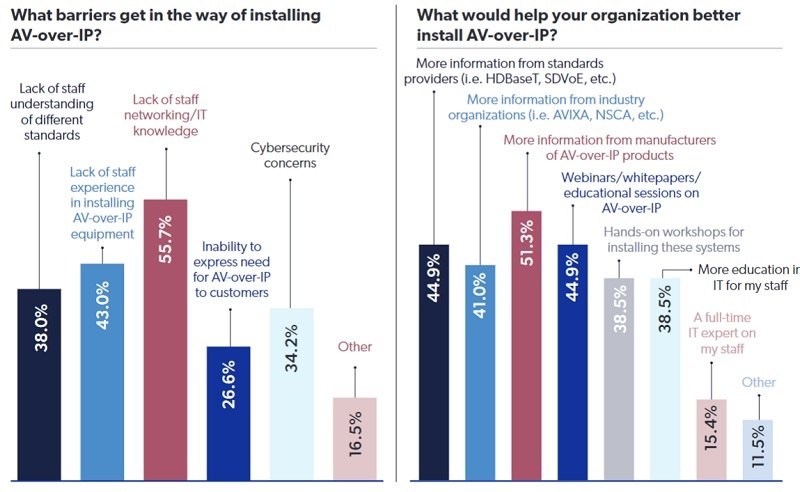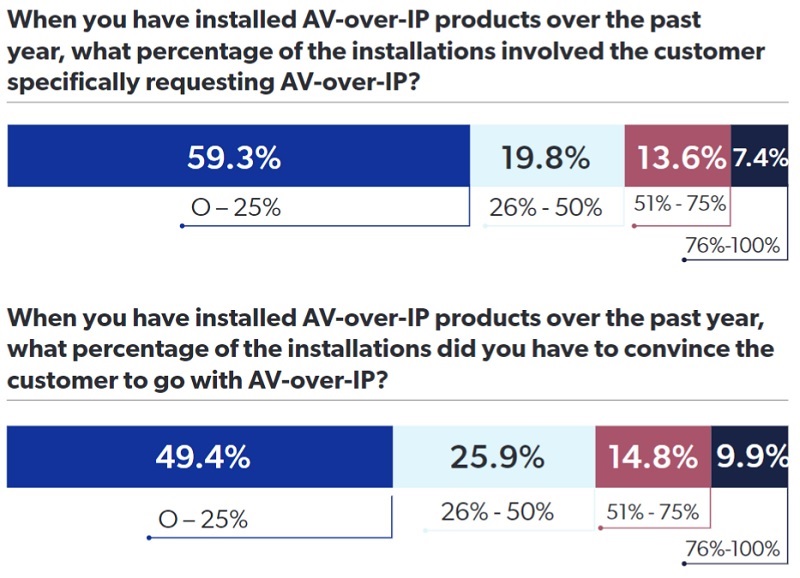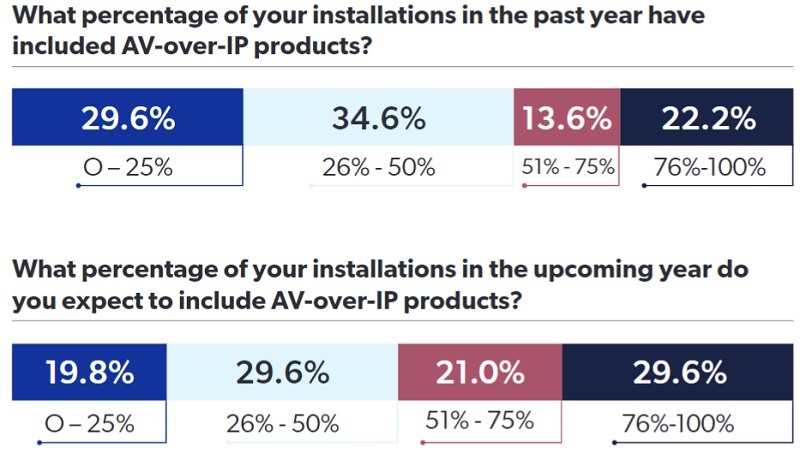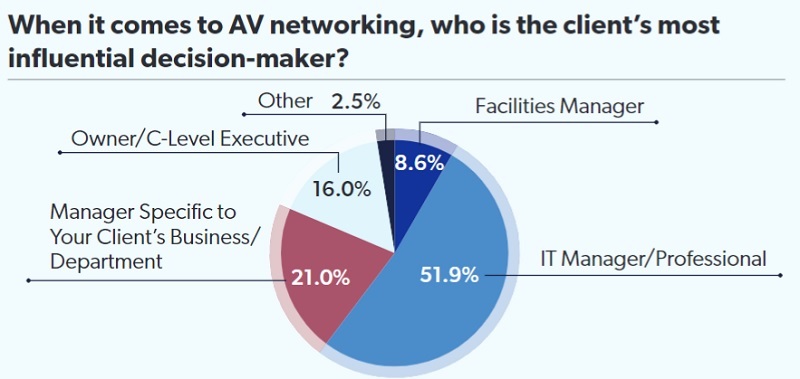AV over IP solutions (AVoIP), at this point, are a new form of signal distribution that most integrators are aware of, if not actively offering as part of their portfolio.
It involves distributing AV and control signals through the network infrastructure, providing enhanced ability to scale, and forgoes the need to connect at a central location as traditional AV distribution systems do.
AVoIP gives integrators the ability to move past the physical limitations of matrix switching. There are times when it makes sense to stick with traditional AV distribution, and times when it makes sense to upgrade to AVoIP.
“Really larger deployments right now are where we’re targeting this type of [AVoIP] solution,” says Brian Fichter, VP of visual collaboration strategy and operation at Carousel Industries. “When we talk about the traditional matrixing – audiovisual digital matrixing – we still do a fair amount.
“Our bread and butter is really around those conference boardrooms – small, medium, and large conference rooms. When you’re talking about onesie-twosies, if you will, the math just doesn’t break out for the AV over IP solutions just yet. My team actually did a matrix and a breakdown of the dollars and cents,” he says.
“But where we do have these larger rollouts [AVoIP makes sense]. We did a $2M rollout very recently, where we did multiple campuses across the globe, and we used the AVoIP methodologies and solutions. It was extremely successful,” says Fichter.
There are several common situations in which making the move to AVoIP makes sense, according to Bill McIntosh, president of BrightTree Studios:
- A single room with a nonlinear relationship between the inputs and outputs. For example, a command and control center with twenty PCs that can be shared to a video wall that can display four sources simultaneously. In that case AVoIP makes sense from a cost standpoint, rather than buying a fixed I/O matrix.
- Building-wide AV distribution. The goal here is to share content from any space in the facility to multiple spaces simultaneously. An example is a corporation’s town hall. There might be a speech to the company that they want to distribute the video in real time to every employee throughout the company. AVoIP can push that video the cafeterias, breakrooms, training rooms, etc. in real time.
- This is especially helpful during the COVID-19 pandemic where social distancing requirements drastically reduces the capacity of a given classroom. AVoIP allows for distance learning measures, where video can be distributed in real-time to multiple classrooms at once, allowing for the virtual expansion of the classroom.
- Scaling and expansion of existing systems. With a matrix switch there is a fixed number of inputs and outputs, so system growth is limited to the infrastructure. You can of course purchase a larger matrix frame, but that involves making an investment to upgrade fixed frames. With AVoIP there is no realistic limitation on the number of inputs and outputs. Not only is it easily expandable, the cost of the expansion is linear and predictable. We know how much an input encoder or decoder costs.
- It’s standard’s based technology. It’s TCP/IP, ethernet, you use the full network stack – AVoIP is an IT director’s dream as long as they understand how to configure their network switches and have the right amount of bandwidth.
“The industry has been longing for some type of standard’s based solutions,” says McIntosh. “This is a way to actually have AV be IT. It’s the only thing we have the follows IT standards. Nothing proprietary. It’s definitely the wave of the future.”
“The vast majority of single, one-off rooms are usually done with fixed frames, and I think that’s primarily because everything is running to the same exact space. They don’t get the benefits of AVoIP, and its simpler to run a transmitter-receiver and keep things off the network. The limitations, though, is length of run,” he says.
Otherwise, as deployments grow, AVoIP makes far more sense from both a cost, scale, and flexibility standpoint.
“The flexibility and the scalability is the draw from the enterprise solutions when you’re talking about global deployment,” says Fichter. “But there is a component of the central management and provisioning from an ease-of-use and ongoing support perspective as well.
“It’s not just the original deployment and provisioning of that original deployment, which is extremely important, don’t get me wrong. Equally as important is the support and ongoing management piece, where Carousel will offer managed services to help our customer base with ongoing support,” he says.
AV over IP solutions by the numbers
We surveyed our integration audience to learn more about how the AVoIP market is growing:
- Respondents suggest that they expect a larger percentage of their projects to include AVoIP this year when compared to the previous year.
- Our respondents say that, more often than not, the integration firm is the one suggesting AVoIP as part of the project, as opposed to the customer requesting AVoIP specifically.
- By far, the most influential decision-maker when it comes to AV networking is an IT manager or IT professional, according to our respondents.
- The vast majority of respondents are ready to fully embrace AVoIP as AV distribution for their customers.
- Corporate and education markets are the most applicable for AVoIP according to our respondents. Of those that chose “other,” most mentioned that AVoIP is not market specific.
- AVoIP has introduced managed services offerings to the portfolio of a significant amount of respondents. When asked what types of managed services offerings, remote support, monitoring, management, and service were most popular.
- Lack of IT and networking knowledge from the integration staff is the largest barrier to installing AVoIP according to our respondents. Lack of staff experience in installing AVoIP, and lack of staff understanding of different standards were also large barriers.
- Respondents suggested that more information from manufacturers and standards providers would be most helpful in preparing their organization to install AVoIP. Webinars, whitepapers, and educational sessions on AVoIP would also be helpful.
AVoIP & the IT department
One of the biggest draws of AVoIP is the familiarity IT departments have with the basic mechanisms (once given a bit of education from the integration firm).
As our survey suggests, the majority of the time the IT department is most influential in making decisions concerning AVoIP projects. As a result, integrators need to ensure they can properly communicate what’s happening with AVoIP – especially considering it involves opening the network to new devices.
“When we’re talking to our customers in the IT space there is an initial investment of time educating on what the platform is and what the benefits of that platform are,” says Fichter.
“When you start talking about re-leveraging existing networks, the PoE aspect of it, not having the additional expense of the additional infrastructure, the security aspects and proofing that out through whitepapers and partnerships with manufacturers, the processing capabilities, the video recording capabilities – it just makes sense quicker it seems,” he says.
“The traditional AV integration space learning curve for those that aren’t in it is sometimes lengthy,” says Fichter. “When talking to true IT customers, explaining AVoIP to them, it’s embraced quicker. It’s learned faster and understood more rapidly.”
It’s not always easy, however. IT pros are protective of their network, and for good reason. Without a background in AV understanding, there may be some failure to communicate up front.
“We have had difficulties with the IT group understanding the network configuration portion of it,” says McIntosh. “AVoIP has to go back to a network closet, then it’s directly running through their network switches, which creates some complexity in their switch configuration.
Related:
“Coordinating all that. Even when you send them configuration sheets ahead of time. There always seems to be an issue,” he says.
However, having staff on the team that understands programming on a deeper level goes a long way toward making that communication happen.
“I was lucky in that our firm had a couple RCDDs on staff who are already very IT savvy. I also had a number of programmers that doubled as engineers that were very well-versed and had a background in computer programming,” says McIntosh. “Not just Crestron, but JavaScript, Python, C++, and other types of language. They were already IT educated.
“We started using people in slightly different roles,” he says. “The engineer that was primarily designing systems is now going out and doing setup and commissioning of AV over IP solutions as well because he already has that skill set.
“It’s slowly trickling down to the people that didn’t have the skill set, but we had a nice head start. It would be hard to start without having some type of knowledge in-house,” says McIntosh.
“Certainly, the network fundamentals have to be there,” says Fichter. “There’s absolutely a security aspect to this, an expertise that should be understood. Really our video collaboration unit took this on initially, and now we’ve reached out to our other disciplines in our data space to get them up to speed.
“We’re cross-pollinating our other divisions within Carousel for the greater good of our customer base,” he says. “Smaller integrators absolutely need to invest in true network expertise while they get their existing staff up to speed, and certainly keep an eye on the security piece of this because it’s critically important.”
Integrators large and small would do well to seek out a staff member that can serve as that liaison to the IT department for AVoIP projects. At the very least, all integrators should be working toward getting some education of their own. Our results suggest that AVoIP is growing, and the potential of the technology suggests that growth won’t stop any time soon.
“I think [AVoIP] is absolutely the future of this space of the AV industry,” says Fichter. “The flexibility, no latency, the ability to do all of these enhanced features that traditional matrixing cannot do – I only see it growing. We don’t see it going backward.”














